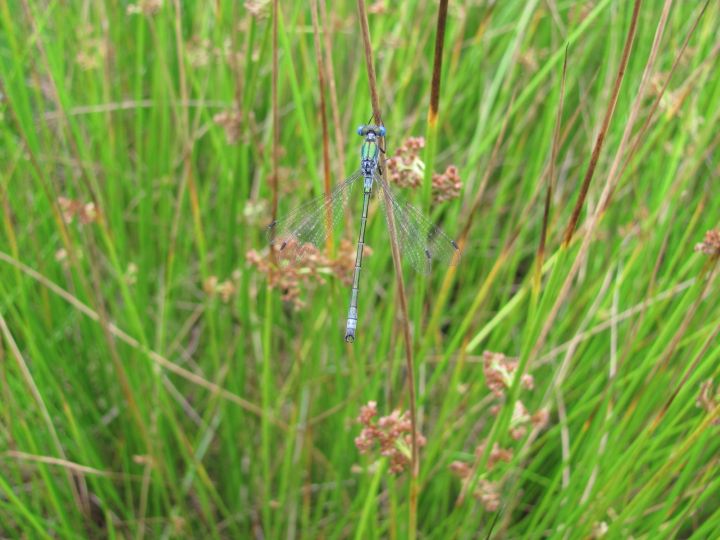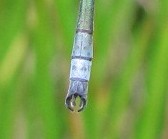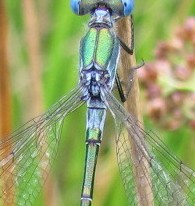Your Forum
This forum has now been more or less replaced by the Club's Facebook page at
The weblog below is for naturalists to use to report interesting sightings, ask questions, report on field meetings and generally post pictures and any information or questions generally relevant in some way to the wildlife and geology of Essex. You will need to
register and be
logged-on to post to the forum, and you need to upload pictures first, for use in posts.
Find out more
Scarce Blue-tailed Damselfly at The Backwarden
 Several emerald damselflys were discovered flying among the thick vegetation surrounding the sphagnum pool at The Backwarden EWT Reserve, Danbury on July 11th. They seemed too robust for Common Emeralds, Lestes sponsa, and thanks to the wonders of digital photography (and its zoom facility) it proved possible to observe the critical distinguishing characteristics between this species and the Scarce Emerald Lestes dryas from even small photographs. To elaborate, the tips of the males inferior anal appendages are bent towards each other at the tip  and the prunosity on segment two of the abdomen is restricted to the top two thirds  . Both these features can be seen (I hope) on the photographs. The Sphagnum Pool meets this species ecological requirements exactly, especially following recent conservation work to remove some of the reedmace surrounding it. It regularly floods in winter and dries out in summer, the mud (resulting from the reedmace removal) being colonised by a thick cover of emerging vegetation such as Juncus rushes, spike-rush and Lesser Spearwort. Later in July several pairs were observed mating and, on August 2nd, females egg laying. In total, around fifteen individuals were seen.
This species has always been associated with coastal borrowdykes in Essex, especially those containing beds of Sea Club Rush. The map in Ted Benton's and John Dobson's 'Dragonflies of Essex' (2007) show only two inland locations (in TQ59 and TQ69), the rest being confined to tidal river systems. The current British Dragonfly Society website maintains the impression that this species is strictly coastal but the population dynamics of dragonflies in this country is changing year or year and I have heard rumours of a number of other inland sites in Essex. Still, it is encouraging that this species has colonised The Backwarden following conservation work, even if that work was intended to benefit the Great Crested Newts! |
|
Archives:
May 2020
Aug 2019
Jan 2019
Sep 2018
Jul 2016
Oct 2015
Jul 2015
May 2015
Apr 2015
Mar 2015
Feb 2015
Jan 2015
Dec 2014
Oct 2014
Sep 2014
Aug 2014
Jul 2014
May 2014
Apr 2014
Mar 2014
Feb 2014
Jan 2014
Dec 2013
Nov 2013
Sep 2013
Aug 2013
Jul 2013
Jun 2013
May 2013
Apr 2013
Mar 2013
Feb 2013
Jan 2013
Dec 2012
Nov 2012
Oct 2012
Sep 2012
Aug 2012
Jul 2012
Jun 2012
May 2012
Apr 2012
Mar 2012
Feb 2012
Jan 2012
Dec 2011
Nov 2011
Oct 2011
Sep 2011
Aug 2011
Jul 2011
Jun 2011
May 2011
Apr 2011
Mar 2011
Feb 2011
Jan 2011
Dec 2010
Nov 2010
Oct 2010
Sep 2010
Aug 2010
Jul 2010
Jun 2010
May 2010
Apr 2010
Mar 2010
Feb 2010
Nov 2009
Oct 2009
Aug 2009
Jul 2009
Jun 2009
May 2009
Apr 2009
Mar 2009
Feb 2009
Jan 2009
Nov 2008
Oct 2008
Sep 2008
Aug 2008
Jul 2008
Jun 2008
May 2008
Apr 2008
Mar 2008
Feb 2008
Jan 2008
Dec 2007
Nov 2007
current posts
|
 Several emerald damselflys were discovered flying among the thick vegetation surrounding the sphagnum pool at The Backwarden EWT Reserve, Danbury on July 11th. They seemed too robust for Common Emeralds, Lestes sponsa, and thanks to the wonders of digital photography (and its zoom facility) it proved possible to observe the critical distinguishing characteristics between this species and the Scarce Emerald Lestes dryas from even small photographs. To elaborate, the tips of the males inferior anal appendages are bent towards each other at the tip
Several emerald damselflys were discovered flying among the thick vegetation surrounding the sphagnum pool at The Backwarden EWT Reserve, Danbury on July 11th. They seemed too robust for Common Emeralds, Lestes sponsa, and thanks to the wonders of digital photography (and its zoom facility) it proved possible to observe the critical distinguishing characteristics between this species and the Scarce Emerald Lestes dryas from even small photographs. To elaborate, the tips of the males inferior anal appendages are bent towards each other at the tip and the prunosity on segment two of the abdomen is restricted to the top two thirds
and the prunosity on segment two of the abdomen is restricted to the top two thirds . Both these features can be seen (I hope) on the photographs. The Sphagnum Pool meets this species ecological requirements exactly, especially following recent conservation work to remove some of the reedmace surrounding it. It regularly floods in winter and dries out in summer, the mud (resulting from the reedmace removal) being colonised by a thick cover of emerging vegetation such as Juncus rushes, spike-rush and Lesser Spearwort. Later in July several pairs were observed mating and, on August 2nd, females egg laying. In total, around fifteen individuals were seen.
This species has always been associated with coastal borrowdykes in Essex, especially those containing beds of Sea Club Rush. The map in Ted Benton's and John Dobson's 'Dragonflies of Essex' (2007) show only two inland locations (in TQ59 and TQ69), the rest being confined to tidal river systems. The current British Dragonfly Society website maintains the impression that this species is strictly coastal but the population dynamics of dragonflies in this country is changing year or year and I have heard rumours of a number of other inland sites in Essex. Still, it is encouraging that this species has colonised The Backwarden following conservation work, even if that work was intended to benefit the Great Crested Newts!
. Both these features can be seen (I hope) on the photographs. The Sphagnum Pool meets this species ecological requirements exactly, especially following recent conservation work to remove some of the reedmace surrounding it. It regularly floods in winter and dries out in summer, the mud (resulting from the reedmace removal) being colonised by a thick cover of emerging vegetation such as Juncus rushes, spike-rush and Lesser Spearwort. Later in July several pairs were observed mating and, on August 2nd, females egg laying. In total, around fifteen individuals were seen.
This species has always been associated with coastal borrowdykes in Essex, especially those containing beds of Sea Club Rush. The map in Ted Benton's and John Dobson's 'Dragonflies of Essex' (2007) show only two inland locations (in TQ59 and TQ69), the rest being confined to tidal river systems. The current British Dragonfly Society website maintains the impression that this species is strictly coastal but the population dynamics of dragonflies in this country is changing year or year and I have heard rumours of a number of other inland sites in Essex. Still, it is encouraging that this species has colonised The Backwarden following conservation work, even if that work was intended to benefit the Great Crested Newts!

















